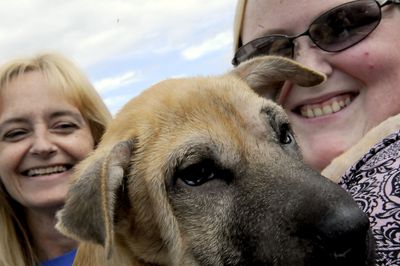California canines find help in Coeur d’Alene

Fires and foreclosures have been forcing more than people out of their California homes – dogs also have been suffering, with many being abandoned as their owners leave the area or move into apartments that won’t accept pets.
Enter Bonnie Whiting and her North Idaho group Alternative Rescue Shelter.
Whiting and fellow dog lover Jenn Pearce traveled to California earlier this summer to rescue 17 dogs destined for “death row,” bringing them to Coeur d’Alene in the back of a van and finding new homes for the canines.
Whiting, a dog trainer, selects dogs to rescue from area shelters as well. She focuses primarily on smaller breeds that are highly sought-after by people who don’t want to deal with the energy and care requirements of larger dogs.
Local animal shelters are filled with larger breeds, so Whiting was surprised to see so many Chihuahuas, toy poodles, terriers and other small breeds when she visited the California shelters.
There were more dogs there than the pair could bring back.
Another 15 dogs were shipped by California rescue groups via plane to North Idaho for adoption.
“We’re trying to plan another trip down,” Pearce said.
The first batch made quite an impact on her.
Pearce fell in love with a puppy named Hannah, adopting the dog herself.
The Coeur d’Alene Pet Resort boards Alternative Rescue Shelter dogs for free until homes can be found for them.
Whiting says she’ll keep up her work as long as adoptable dogs are left in kill shelters.
“You can’t save everybody,” she said, “but you can save some.”
Hearing on shoreline plan set
A revision of the city’s shoreline master plan – including new regulations on the height and mass of buildings near Spokane River and Latah Creek – is the subject of a public hearing on Wednesday before the city Plan Commission.
Under the proposal, developers in coming years would no longer be able to erect large high-rise towers, but rather would have to build skinnier towers to allow views around them. Buildings shorter than 55 feet would be allowed to cover larger areas.
The Plan Commission takes up the new regulations, including a river bank restoration plan, on Wednesday at 5 p.m. in Council Chambers at City Hall.
The commission is expected to make a recommendation to the City Council, which would hold a public hearing at the end of October, city planners said.
For details on the proposed shoreline master plan, go to the city Planning Department Web site at www.spokaneplanning.org/ shoreline_update.htm.
‘Voice of the Valley’ featured
The “Voice of the Valley” KZUN Radio is back on the air as part of a new exhibit on the longtime Valley radio station at the Spokane Valley Heritage Museum.
An old-fashioned radio plays songs from the station’s Big Band format interspersed with the “Kissin’ KZUN” jingle. The exhibit also includes photos of announcers Bob Swartz and Art MacKelvie, the station and its billboards.
Jerry Anderson joined MacKelvie at the museum; Anderson served as the station’s announcer, news director and later operating manager. The two hadn’t seen each other in 35 years.
KZUN was started in 1955 by MacKelvie and Swartz, both veterans of KHQ radio. It aired on 630 AM and 96.1 FM from a studio near Sprague Avenue and Pines Road.
No one wanted to loan the duo money to launch the station, but they pulled everything together.
“We kind of made our living on Lawrence Welk,” McKelvie said. “We called it happy music. We’d sign off at night, empty the wastebaskets and try and sell advertising. It was fun.”
County lacks court holding area
It’s been months since Kootenai County building officials condemned the structure where defendants would sit, in secure cells, waiting for a court hearing.
Since the Worley Building was deemed unsafe, the county doesn’t have anywhere to hold defendants other than the vans used to transport them from jail to the courthouse.
“It’s just a horrible mess,” sheriff’s Lt. Neal Robertson said. “The Worley Building was bad. We’ve gone from bad to worse.”
Other than temporary chain-link fencing around the vans, Robertson said, there is no security. Inmates are paraded in plain view from the vans to the courthouse – often past curious onlookers and even jurors who aren’t supposed to see defendants in handcuffs and chains.
Sheriff’s officials have concerns about escape attempts, the safety of deputies and courthouse bailiffs, and what to do once the snow hits and temperatures drop.
“We’re making a bad situation work right now,” said 1st District Judge John P. Luster, administrative judge for the five northern counties of Idaho.
There aren’t really any other options – at least in the near future.
County Commissioner Todd Tondee said the county plans to demolish the Worley Building and construct a new building, up to six stories tall, which would have a court-hold facility in the basement, along with a secure sally port where inmates could be transferred from vans into holding cells.
The building also could house the Kootenai County prosecuting attorney’s office and the offices of the public defender, freeing up space for additional courtrooms and judges chambers.
That all hinges on voter approval of an estimated $145 million bond, which would be repaid through a local-option sales tax.
Funds would allow for expansion of the Kootenai County Jail and a new sheriff’s administration complex in addition to the new building on the courthouse campus in downtown Coeur d’Alene. If voters approve, it will be 18 months to two years before the buildings are constructed, Tondee said.
If the measure doesn’t pass, Tondee said, the county will have to look at renting space.